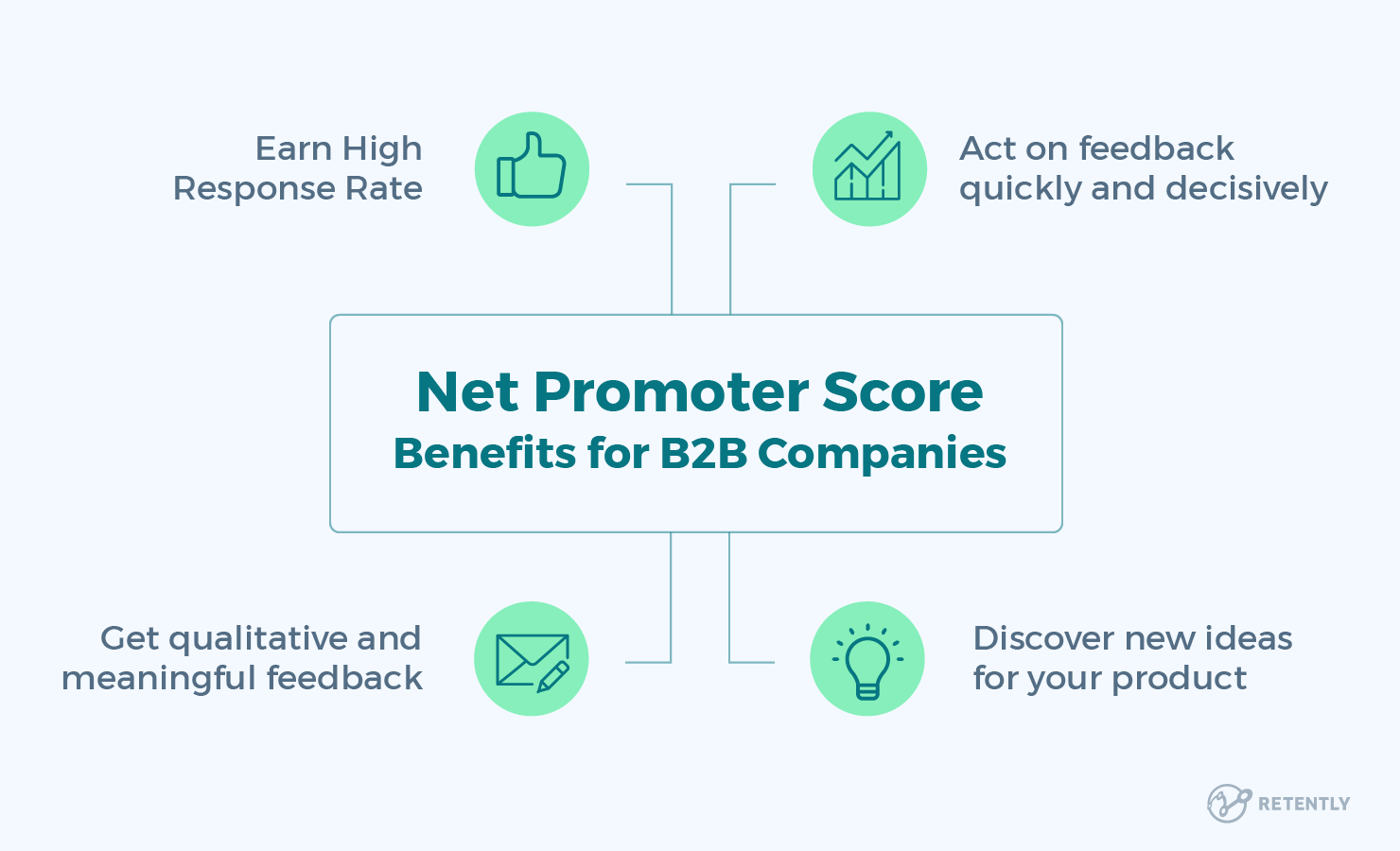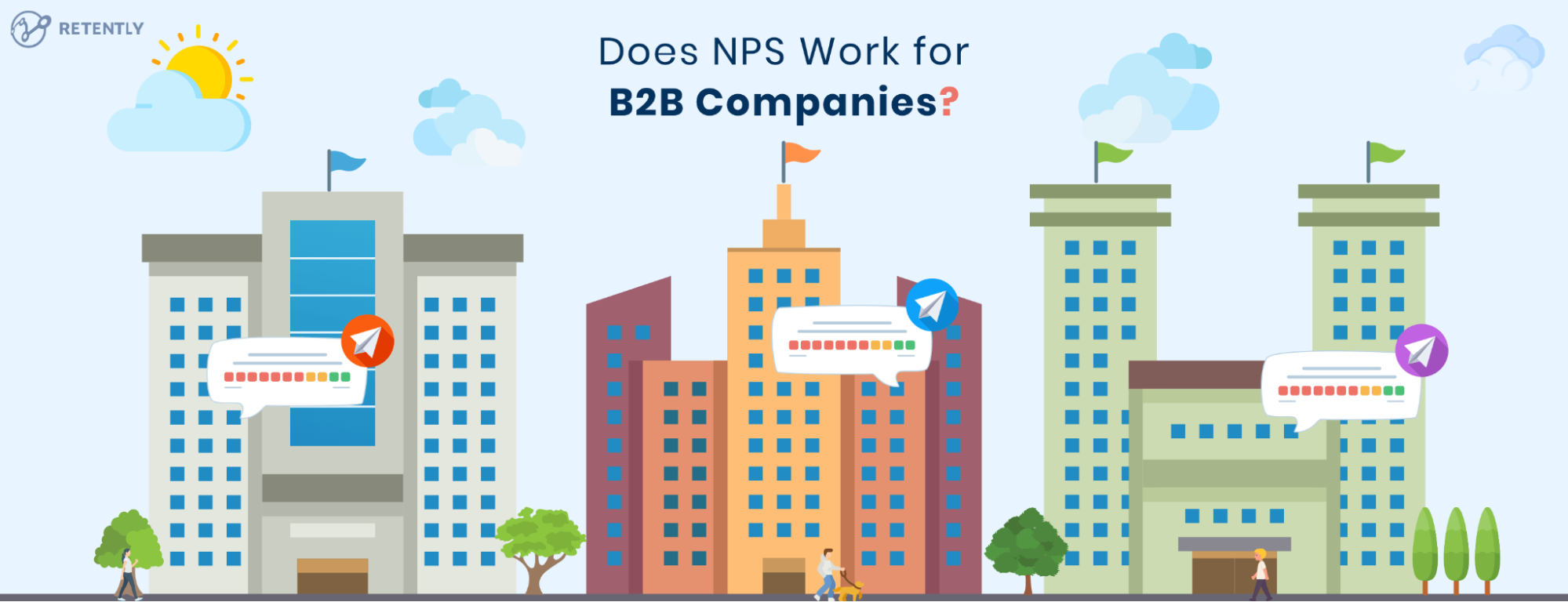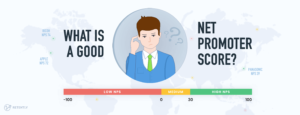Some people argue that NPS® doesn’t work effectively for B2B companies. We argue the opposite — Net Promoter Score® is just as valuable for a B2B company as it is for a B2C brand.
One reason for this common misconception is that almost all of the content available both online and offline about NPS® is aimed at a B2C audience:
- Most NPS guides are written with B2C brands in mind, using terms like “customers” instead of “clients” or “accounts”.
- The scale of NPS, in terms of the ability to reach thousands or tens of thousands of customers, just isn’t as applicable or relevant for an average B2B company.
Of course, this doesn’t mean that NPS isn’t an effective tool for B2B companies hoping to gain more clients and retain a greater percentage of their existing client base. In fact, NPS can be a powerful tool — possibly the most powerful at your disposal — for improving B2B retention.
Here’s why:
B2B surveys earn a higher response rate
Search online for information about the weaknesses of NPS for B2B companies, and you’ll find a lot of content focusing on the limited scale of the average B2B company’s audience.
While it’s true that B2B companies typically have fewer customers than B2C companies, there’s a flip side to this coin.
Unlike most B2C interactions, B2B relationships are not quick transactions – they’re partnerships built over time based on mutual trust, shared goals and benefits. What’s more, B2B transactions are not impulsive purchases but strategic decisions. As a result, B2B clients often feel a responsibility to provide feedback since it means optimizing their partnership and business operations.
Thus, in B2B, NPS surveys become a channel for mutual growth, with businesses keen on leveraging them to communicate expectations and concerns. Because of this close-knit relationship between a B2B company and its clients, it’s much easier for a B2B company to generate a high NPS survey response rate.
As we’ve explained before, the response rate is one of the most important factors for calculating the quality of NPS data. A higher response rate means better customer engagement, which in turn translates into greater accuracy and a reduced risk of sampling and selection bias.
According to Bain & Company, the target NPS response rate for business-to-business brands is 50% higher than the average target for consumer-focused brands. While B2C businesses aim for up to 40% response rate, B2B companies are encouraged to seek a response rate of 60% or even more, when combining survey channels.
The response rate has a massive effect on the statistical validity of any survey. Thanks to the higher response rate of B2B NPS surveys, business-to-business companies can have more confidence in their data which allows them to make meaningful, effective decisions to improve customer retention.
Closing the feedback loop is easier
Another benefit of using Net Promoter Score for your B2B company is that you’re far more able to act quickly and decisively on customer feedback.
When you run a B2C business with hundreds of thousands of customers and tens of thousands of survey responses, sorting through feedback and quantifying which parts of your product or service need attention is a major challenge.
If your NPS software doesn’t offer a reliable feedback segmentation feature, then this can lead to analysis paralysis — endless analysis about which factors deserve attention the most, leading to a lack of action from your business and a total lack of improvements to your product or service.
In the meantime, instead of retaining Detractors that voiced their feedback on how you can improve (or better yet, working with them to turn them into Promoters), you’re far more likely to simply lose their business.
In B2B, however, it’s possible to make rapid changes to your services and processes that will help you turn Detractors into Passives, Passives into Promoters, and Promoters into enthusiastic and motivated evangelists for your company.
B2B companies work closely with a smaller client base, meaning they can gain a deeper understanding of specific needs and challenges. With fewer feedback sources, B2Bs can easily sift through NPS responses, pinpoint concerns and act accordingly.
Additionally, B2B interactions usually involve account managers, regular meetings and open channels for dialogue. Due to the high financial and operational stakes, there’s already a procedure in place for promptly discussing feedback upon receipt. This speeds up the process of addressing issues and adds a personal touch to the feedback loop.
The deeper your relationship with your customers, the easier it is to generate feedback and implement meaningful changes. In B2B, close business relationships are a norm, giving you far more power to act quickly on feedback and constantly improve customer satisfaction.
Strong relationships generate more meaningful feedback
In addition to helping you gain a higher response rate and a greater number of responses relative to your total audience size, a B2B customer base is more likely to produce meaningful, high-quality feedback that helps you improve your product or service.
Great B2B companies revolve around teamwork, both between your team members and your team and its clients. This creates a stronger, deeper working relationship in which information flows freely from one party to the other as a matter of delivering your service. Because both sides aim for the same goals, feedback becomes solution-oriented. It’s not just about pointing out what’s wrong but about jointly finding ways to improve.
As a result, it’s far easier to generate high-quality, actionable feedback from B2B customers than from B2C. After all, you’re not a stranger to them — instead, you’re a trusted partner with a real working relationship.

Customers are more likely to contribute useful ideas
In B2C, it’s far from uncommon for customers to stick with one brand and ignore offerings from others. Usually, customers stay loyal to a company that feels familiar, personal and is a great fit for their needs in terms of product pricing and quality. For example, a customer that’s satisfied with a certain car manufacturer might stick with them for years – or with an electronics brand, clothing retailer or athletic shoe company.
In B2B, it’s far more common for customers and clients to experiment with a number of products and services from different companies. And that’s mostly because business-to-business companies have a certain list of mandatory requirements, such as certifications, security guarantees, etc. After all, B2B is all about results, and there’s no better way to produce better results than to experiment with different vendors.
This means that your customers can be a useful source not just of feedback on your product or service, but of ideas that can help you overcome your competitors.
If your clients and customers have used a variety of competing products and services, they can often tap into their experience to tell you where your offering excels, where it’s lacking and how it can best improve to outperform the competition.
When responding to NPS surveys, B2B clients are not simply ticking a box. They’re sharing insights drawn from their daily experiences in order to drive improvements that will benefit their operations.
Hence, their suggestions often cover a range of areas relevant to B2B progress:
- B2B customers are aware of the challenges and opportunities within their sector. Since their feedback is rooted in this industry-specific context, their ideas are insightful and highly actionable.
- With a keen eye on upcoming trends, their NPS responses can preview what’s to come, helping companies maintain a competitive edge.
- When channeled through NPS, B2B feedback goes beyond minor fixes. It often includes broader improvements – such as integrations and scalability – allowing products to grow as the industry does.
- B2B clients’ insights help businesses make sure they’re not just good but also in line with the best in the industry.
It’s easy to miss out on innovation opportunities when you’re stuck inside the “bubble” of your company’s daily operations. Tap into your customers’ knowledge and discover great ideas for new features, improvements, and enhancements to your product or service.
NPS is a predictive tool for account growth and retention
NPS isn’t just another metric on the dashboard; it’s a tool that predicts and shapes account growth and retention. B2B companies looking to boost their relationships should not only adopt NPS but embed it into their core strategy.
So, what makes NPS so special for B2B?
Instead of reacting to feedback, B2Bs can use NPS scores to anticipate client needs and potential churn. It’s not just about understanding current satisfaction but also the future of client relationships. The simple question, “How likely are you to recommend our service?”, when answered in the B2B context, can affect a company’s reputation and years of work.
Yet, growth isn’t about casting a wide net; it’s about targeting the right opportunities. NPS identifies not just the happy clients but also pinpoints the areas needing improvement. It’s like having a roadmap to your growth strategy.
A high B2B NPS score translates into trust, satisfaction, and, of course, opportunity. When clients regularly express a high likelihood to recommend, it’s a sign that there’s more room for growth. Companies can spot areas to expand their offerings, introduce new features, or deepen integration into operations by tapping into the reasons behind a high NPS score.
On the flip side, if your NPS drops, pay attention. A lower NPS score might be their way of saying, “Let’s chat.” This is your clue to engage, ask questions and redefine your approach. For more ideas, check our article on what companies with a low NPS have in common.
High retention rates are the golden goose for B2B businesses. With NPS, B2Bs get actionable insights into what’s working and what’s not. Addressing these areas proactively not only increases the CLV and strengthens bonds but also turns them into advocates.
B2B surveys offer streamlined insights for stakeholders
Especially in B2B, information comes at you fast and thick. Stakeholders are often overwhelmed with charts, graphs and spreadsheets. That’s where NPS steps in.
Imagine being able to gauge a client’s loyalty, the quality of your product or service, and even the potential for future growth, all from a single number. NPS captures it all. It’s like a quick health check-up for your business relationships.
For stakeholders, this means swifter insights and better decision-making. There is no need to go through lengthy reports or complex data presentations. NPS offers B2Bs a snapshot of how clients feel about doing business with them. CEOs can quickly grasp client sentiment, sales teams can assess account health and product managers can spot areas that need attention.
Think about it this way: in the hectic B2B environment, every minute counts. It means more time brainstorming fresh ideas, building ties and pushing the envelope.
Beyond the Score: B2B NPS Challenges
While its benefits are plentiful, NPS isn’t without its challenges. B2Bs involve multiple stakeholders, each with their own point of view. So, can one metric truly capture the essence of collective feedback?
The complex nature of B2B relationships means that relying on a single metric may oversimplify sentiments at play. A company could receive a high NPS from one department and a low score from another, leading to confusion. There’s also a risk of over-relying on numbers and misinterpreting data without the context that qualitative feedback offers.
For example, if the B2B NPS score suddenly drops, it might ring a bell. But without understanding why it happened, trying to fix it might not work well. Likewise, if the scores are always high, you might feel things are fine, but hidden issues could still exist. To really make NPS work, you need to use it with detailed feedback for more context.
In B2B, buying decisions aren’t made by just one person. It’s a team effort – from technical experts to C-level executives. Each brings to the table their unique experiences and perspectives. In such a scenario, whose feedback does the B2B NPS represent? A high score from a key contact might contrast with reservations from a product user. So, companies need to be careful when interpreting data. They shouldn’t think a piece of feedback speaks for everyone.
To make the most of NPS, it’s essential for B2B companies to approach it not as a standalone solution but as part of a comprehensive feedback toolkit. By understanding its strengths and limitations, B2Bs can use it effectively and stay connected with their partners.
However, it’s also important to remember that while NPS provides valuable insights, it’s just one piece of the puzzle. Incorporating several customer satisfaction metrics can provide a more complete view of the overall customer experience.
Behind the Scenes: NPS Implementation in B2B
The dynamic of B2B relationships requires a tailored approach to NPS implementation. Here are some practical ideas for B2B companies looking to make the most of NPS.
1. Customize the NPS survey for B2B audiences
Because B2B decisions involve multiple persons, tailor your NPS surveys based on roles. For example, a CEO might be more concerned about cost-effectiveness, while actual users would prioritize technical efficiency. Hence, you will better understand your performance by segmenting survey recipients.
Timing is of the essence. Consider sending NPS surveys after a major milestone or at the end of the quarter while ensuring the feedback is tied to recent experiences.
B2B relationships thrive on personal connections. Customize your surveys to address the respondent by name and mention specific interactions to make the feedback process more personalized and relevant.
2. Complement NPS with qualitative feedback sources
After the default NPS question, make sure to include follow-up open-ended questions to provide context to the score. Here are some NPS survey question templates to choose from.
Set up regular feedback calls with key clients. These face-to-face interactions allow in-depth discussions, surfacing issues that surveys might miss. Encourage your B2B clients to view feedback as an ongoing dialogue, not a one-off activity.
3. Analyze and act on B2B NPS feedback
Use real-time dashboards to monitor NPS scores. This way, you’ll be always in tune with client sentiments and able to respond promptly to any change.
For any shifts in NPS, whether they’re positive or negative, take the time to figure out why they happened. Find out the main reasons behind the change, allowing for more targeted action.
Once you’ve acted on the feedback, circle back with the B2B respondent. Informing them about the applied changes will build trust and show you value their partnership.
Keep in mind that implementing NPS in B2Bs is not a one-size-fits-all approach. It’s about finding what works best for your company and clients. Take your time to get it right. That’s how you master the routine and build meaningful relationships in the long run.
Is your B2B company using NPS effectively?
From deeper, more actionable feedback to the statistical accuracy made possible by a higher response rate, using Net Promoter Score to survey your B2B customers has a wide range of benefits.
Is your B2B company using NPS effectively? Retently lets you automatically survey your clients and customers using Net Promoter System to generate meaningful feedback and learn exactly how your business performs.
Learn more about Net Promoter Score and start your NPS campaign with Retently.

















 Alex Bitca
Alex Bitca 

 Christina Sol
Christina Sol 

 Greg Raileanu
Greg Raileanu 


